Let’s dive into this Johnson & Johnson (JNJ) spinoff—because it shows exactly how we can tap “splits” like these to grab not one but TWO income streams growing 200%+.
Because if there’s one thing we need to know about spinoffs, it’s this: they’re about the closest thing to a free lunch you’ll find in investing. Just ask Peter Lynch, who guided his Magellan Fund to an astounding 29.2% annualized return from 1977 to 1990. His take on spinoffs, in his 1989 investing masterclass One Up on Wall Street, was simple:
“Spinoffs of divisions or parts of companies into separate, freestanding entities … often result in astoundingly lucrative investments.”
Okay, I’ll admit—I threw the italics on those last three words, but only because Lynch is right on the money here. Truth is, spinoffs pay off for folks who own both the parent and the “new” firm. And they can pay off double for dividend investors, as we’ll see next.
JNJ Split Will Drive Payout Growth
Let’s round back on JNJ’s spinoff of Kenvue (KVUE), which till recently was its consumer-products division. On July 20, Kenvue announced its first quarterly dividend post-spin: $0.20 a share, for a current annualized yield of 3.5%.
Not bad! That’s more than double what the typical S&P 500 stock pays.
As this is a spinoff, you might expect JNJ to drop its payout by $0.20 to compensate, but nope: JNJ will keep its payout at $1.19 quarterly and said it expects faster sales growth post-spinoff, and faster growth in earnings per share, too.
That’s another happy knock-on effect of spinoffs: with fewer products to focus on, management can better focus its energy. Moreover, as JNJ offered to exchange its shares for shares of the new firm under the spinoff, the resulting drop in the share count cuts JNJ’s shares outstanding.
Kenvue Spinoff Slashed JNJ’s Share Count
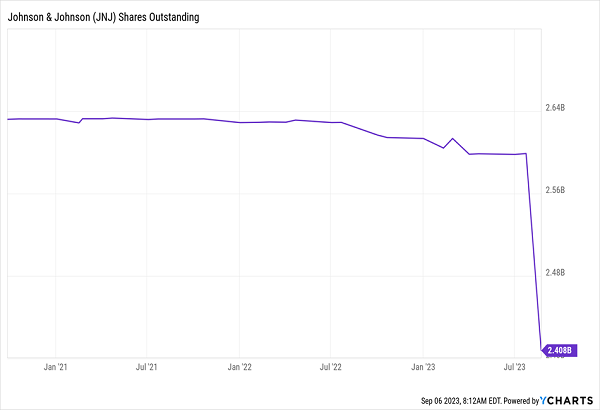
This works like a share buyback, and we’ve spoken before about how buybacks increase earnings per share, due to the lower share count, which can boost share prices (this effect is already helping minimize the loss of Kenvue on JNJ’s EPS).
Throw in the fact that JNJ’s share price has lagged its dividend in recent months and you’ve got another upside indicator, as its “Dividend Magnet” goes to work:
JNJ’s Dividend Lags Its Price Growth (for Now)
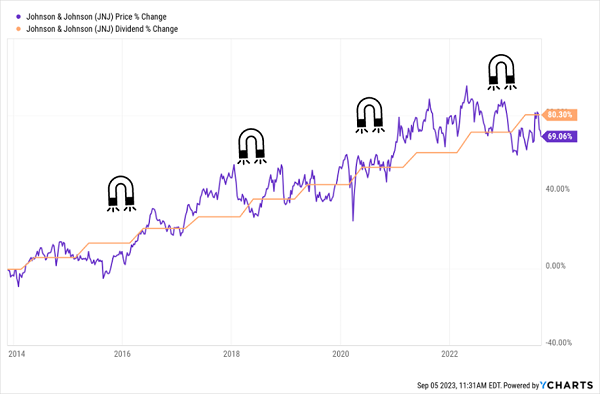
The bottom line? We’d likely do just fine picking up this duo. But we’d do even better grabbing spinoffs with payouts growing even faster than JNJ’s, as we’ll see next.
JNJ/Kenvue “Prequel” Shows How to Tap Spinoffs for Max Gains, Divs
To see what I’m getting at, consider the split of medical-equipment maker Abbott Labs (ABT) from pharmaceutical firm AbbVie (ABBV), which occurred back in 2013. That’s a long enough timeframe for us to see the full effect of the breakup.
Let’s start before that split: below we can see that the dividend of the parent company, Abbott, more than doubled in the 10 years prior to the split. That’s much faster than JNJ’s payout has grown in the last 10:
Abbott’s Pre-Spin Dividend-Growth Outraces JNJ’s
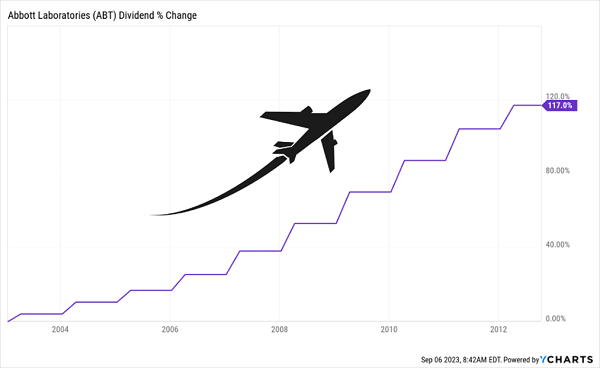
On the day of the split, Abbott investors were handed one share of AbbVie for every Abbott share they owned, and the new firm set its payout at $0.40 a share quarterly.
Abbott, for its part, had reduced its payout to $0.14 a share to account for AbbVie’s dividend, so investors now had two dividend streams that paid them $0.54 a share in all—more than the $0.51 they were getting from the “old” Abbott.
It got better because the spinoff ignited the payout, with both firms’ dividends surging 244% on average, more than double the rate Abbott’s grew in the preceding decade.
Spinoff Was a “Dividend Igniter” for AbbVie and Abbott

And if Abbott investors held on to their AbbVie shares, their holdings skyrocketed as other income-seekers noticed these hikes and bought in, driving up the prices of both companies in lockstep with their rising payouts:
… And Lit Up Their Share Prices, Too!
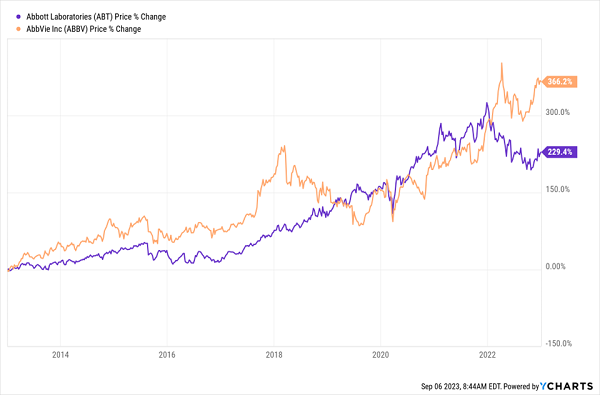
Spinoffs and Surging Payouts Tilt the Odds in Our Favor
You can likely see where I’m headed here: buying stocks that are about to split and have payouts that are not only growing but accelerating is the key to unlocking big profits.
The best news is that, to tap the biggest gains, you don’t have to be clairvoyant: even if you’d bought Abbott and/or AbbVie during the first few months after their separation, you’d have still bagged most of the gains both stocks went on to deliver.
That’s because new spinoffs tend to stagnate for the first while as investors who were handed them decide whether they want to hold on. That lag is also dragged out by the lack of coverage of “boring” spinoffs on Wall Street, which gets more worked up about IPOs and the trend du jour, like crypto, electric cars, AI or whatever.
How to Spot a Spinoff Before It’s Announced
Pretty well all spinoffs have one thing in common: they come from companies that have one or more divisions whose products don’t overlap with one another. You can see this with JNJ and Kenvue, as well as with Abbott and AbbVie.
Companies that conduct spinoffs also tend to grow by acquisition, as was the case with information-technology manager Synnex (SNX), whose payout had tripled in the five years before we bought it in my Hidden Yields dividend-growth service in October 2019.
We did so because this stock was trading “too cheaply” after acquiring customer-service consultant Convergys. The resulting higher debt had spooked Mr. Market, but we anticipated that SNX, which has made 24 acquisitions in its 43-year history, would have no problem paying down the credit.
The result? We went on to enjoy 83% total returns from the stock in two years before selling in October 2022:
Our “Parent Company” Buy Soared 83% (and It Was Just the Start)
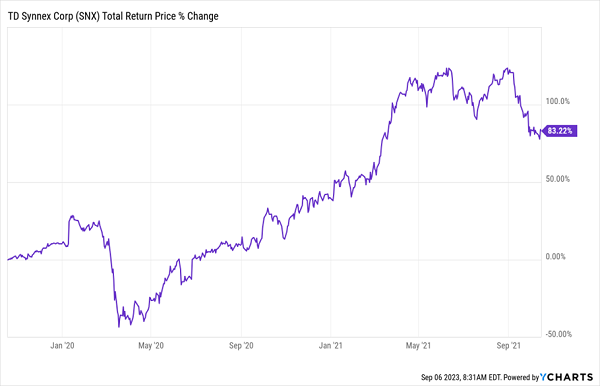
It gets better: smack in the middle of our holding period, Synnex spun out Concentrix Corp. (CNXC), which provides customer-service solutions and works with many of America’s top tech firms. We were “handed” the shares in December 2020, and a little over a year later, on December 17, 2021, we sold CNXC for a 111% total return.
So we once again proved Lynch’s point here, with payout growth assisting on our spinoff gains.
Spinoff Strategy Step 1: Find the Dividend Magnet
Spinoffs are a proven way to profit, especially—as we just saw—if their payouts are surging and their share counts are dropping. But it’s not easy to find these “Peter Lynch–style” winners on your own.
That’s why I’m inviting you to road test Hidden Yields for 60 days risk-free. In Hidden Yields, we zero in on the fastest-growing payouts (which, in turn, drive the fastest-growing share prices) to book big gains, as we did with Synnex and Concentrix.
These shareholder-friendly stocks are the ones most likely to spin off businesses as they look to unlock more value for investors. So simply by zeroing in on dividend growth and buybacks, we’re naturally giving ourselves a shot at “bonus” upside through spinoffs.
Here’s how you can take advantage: Click here and I’ll tell you more about my Dividend Magnet strategy and give you the opportunity to download a free Special Report naming 5 of my top dividend-growth picks. Along with that breakthrough report, you’ll also be able to kick-start your 60-day trial to Hidden Yields. I urge you not to miss this opportunity for price gains and surging payouts, too.
